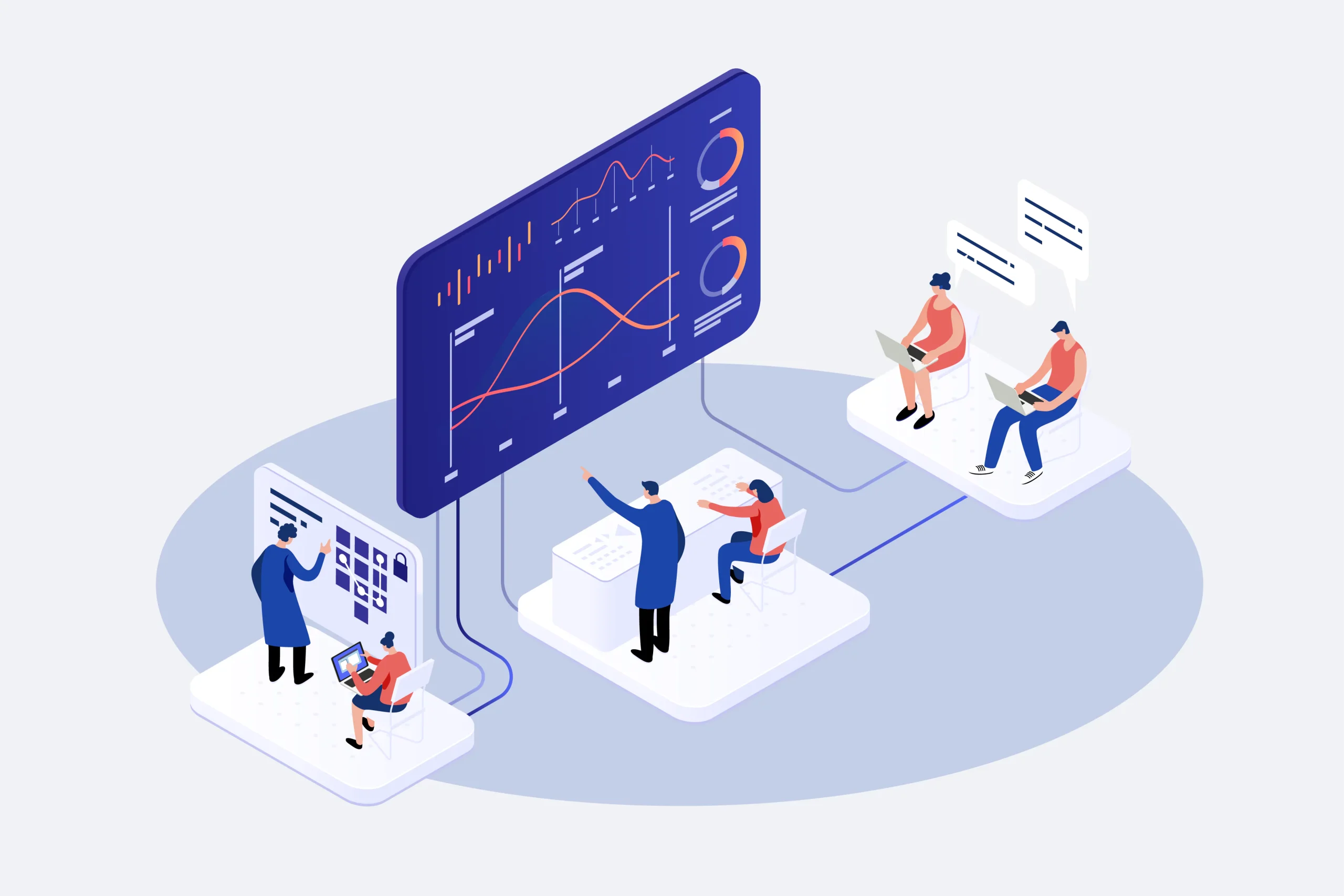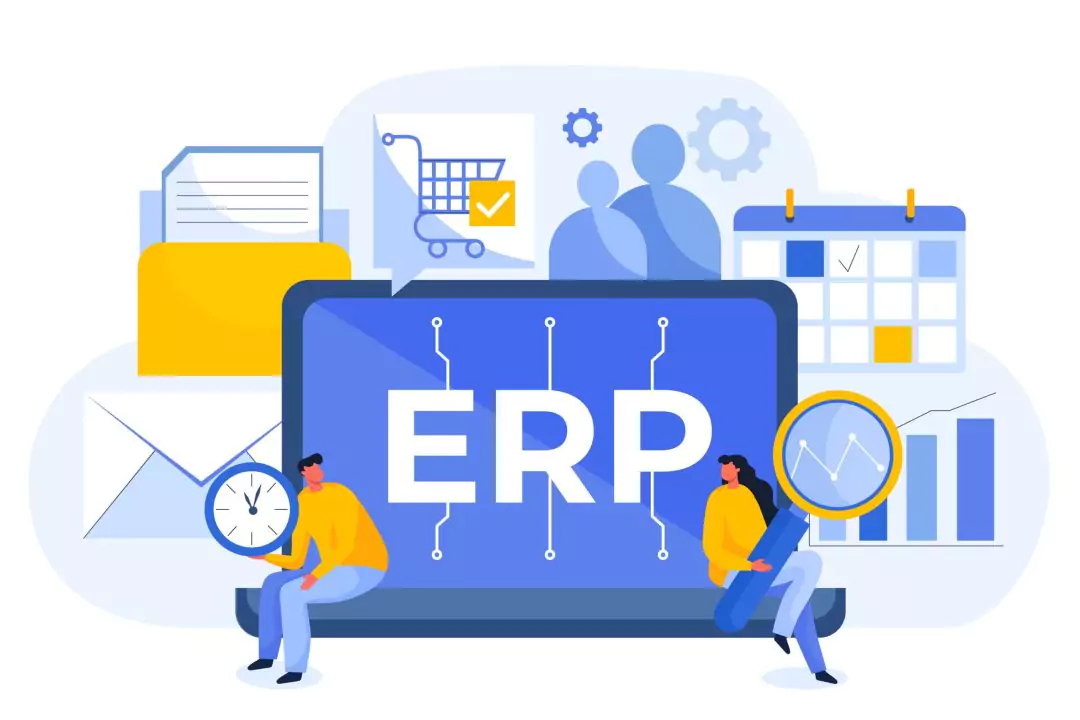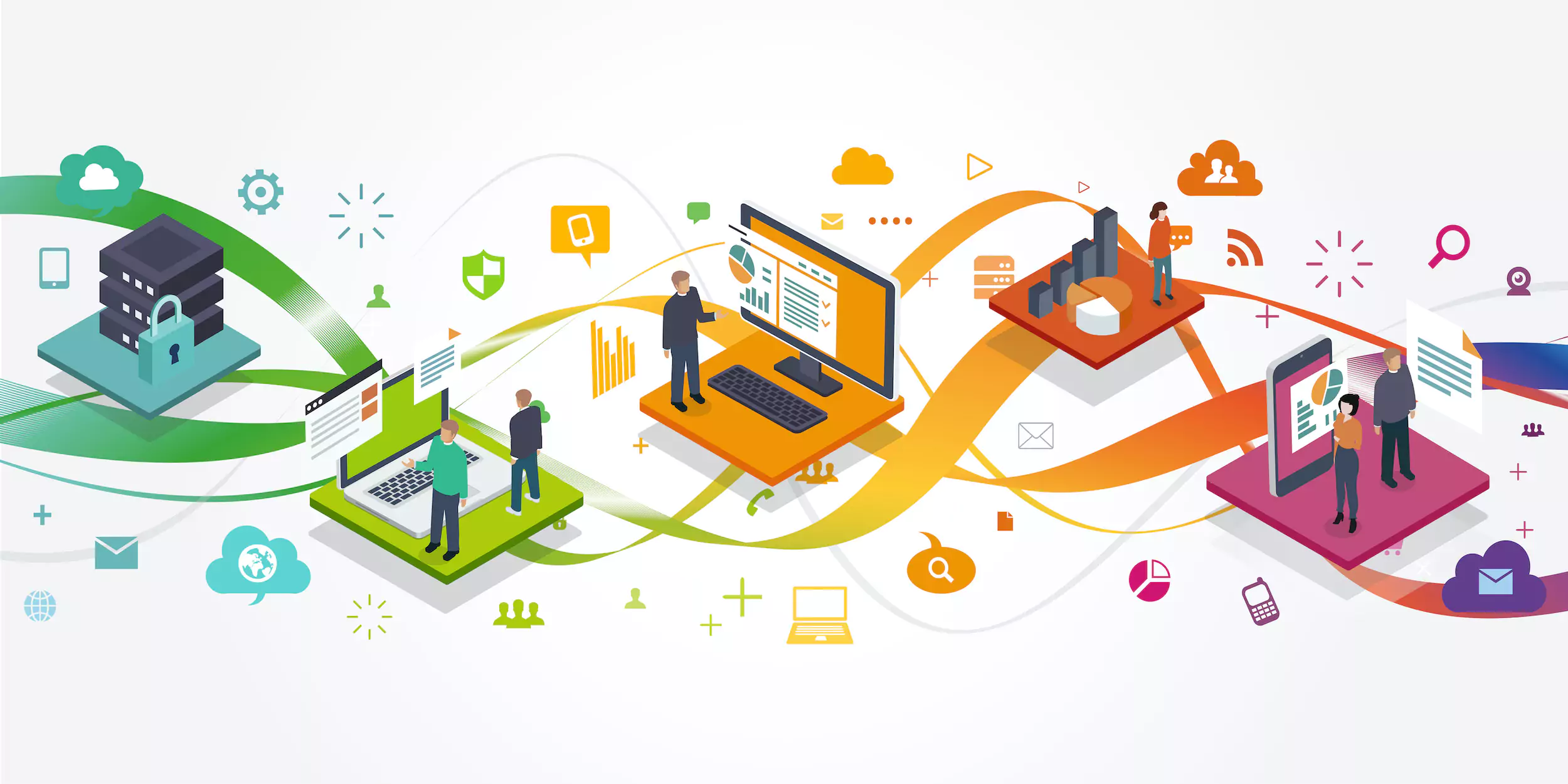Upon entering the digital sphere, you are likely familiar with the terms digital transformation vs digitalization. In many resources about the digital world, these terms are often used interchangeably. Despite their resemblance in pronunciation, each word has an entirely different meaning. This article will provide a thorough comparison of digital transformation vs digitalization, including the definitions of each term, the key distinctions between them, and how you can leverage them in your business practices.
Table of Contents
- Digital transformation vs digitalization: Overview
- Digital transformation vs digitalization: detailed differences:
- Digital transformation vs digitalization: How business can leverage them?
- Importance of understanding the difference between digital transformation vs digitalization
- The synergy between digital transformation and digitalization
- Trends in Digitalization & Digital Transformation
Digital transformation vs digitalization: Overview
What is digitalization?
Digitalization is a tactical process that focuses on the conversion of analog information and processes into digital formats. It involves the use of digital technologies to streamline and automate specific tasks or functions within an organization.
Digitalization can be a crucial component of digital transformation, but it is not the same thing. Digitalization can bring immediate benefits in terms of cost reduction, increased efficiency, and improved data management, but it does not necessarily involve a broader strategic shift in the organization’s overall approach. While digitalization is a valuable step towards becoming more digitally mature, true digital transformation encompasses a more profound and holistic organizational change.
Example of digitalization
The digitalization process often starts with digitizing paper documents, manual workflows, or physical assets, making them accessible, searchable, and more efficient. Examples of digitalization involve using digitalized customer data from multiple sources to generate behavioral insights automatically; or leveraging digital technologies to help change the way companies do their business.
Digitalization applications in various industries include
- Retail: With the growing market share of online retailing, large companies like Amazon have applied digitalization to improve their business performance through automation, cloud computing – AWS, and data leveraging.
- Finance: The implementation of digital payment methods, including PayPal, Apple Pay, and Google Wallet, demonstrates the pervasiveness of digitization. The utilization of these technologies facilitates and optimizes the transaction process for customers, irrespective of their geographical placement, in the context of any business.
- Healthcare: The healthcare industry is implementing digital technologies to enhance patient care. Illustrative instances encompass electronic patient records, which facilitate expedited access to critical medical data for physicians, and telemedicine, which empowers patients to engage in online consultations with physicians.
What is digital transformation?
Digital transformation is the broader term for digitalization. This comprehensive and strategic process involves the integration of digital technologies, data analytics, and innovative business models to fundamentally change how an organization operates and delivers value to its stakeholders.

Digital transformation goes beyond merely adopting digital tools or automating existing processes; instead, it aims to reshape the entire organizational culture, processes, and strategies. It typically encompasses a range of objectives, including enhancing customer experiences, optimizing operations, fostering innovation, and staying competitive in an increasingly digital and interconnected world.
Being a process that requires a massive organizational change, digital transformation requires a top-down commitment, often led by leadership, to drive meaningful change, and adapt to emerging technologies, and capitalize on the vast amounts of data available in today’s digital landscape. Ultimately, the goal of digital transformation is to position an organization for long-term success in the digital age by enabling agility, efficiency, and the ability to capitalize on new opportunities.
Example of digital transformation
Digital transformation represents a more extensive and strategic shift that fundamentally changes how organizations operate and deliver value to their stakeholders. It is a long-term journey that requires a great deal of time and resources to accomplish success. Here are some real-life digital transformation case studies to illustrate
- Netflix and Streaming Services: Netflix is representative of disruptive innovation. By shifting from traditional cable TV to a digital streaming model, they revolutionized the video-streaming industry and completely outperformed the market leader at the time, Blockbuster. By utilizing personalized content recommendations and ensuring global accessibility, their customer-centric strategy caused a significant upheaval in the media industry, ultimately leading to a redefinition of content consumption and payment methods.
- Amazon’s Ecosystem: The digital transformation endeavors of Amazon transcended the realm of eCommerce. By implementing robots in their fulfillment centers, they transformed supply chain management. Additionally, they introduced cashier-less grocery stores through Amazon Go and even dabbled in original content production. Another illustrative instance is Amazon Web Services (AWS), a cloud computing platform that offers enterprises an IT infrastructure that is both scalable and economically viable.
- Tesla and Electric Vehicles: Tesla‘s digital transformation goes beyond electric cars. They continually update vehicle software to improve performance and safety, demonstrating how automotive companies can integrate software and connectivity into their products. Their over-the-air updates exemplify digital innovation in a traditionally hardware-focused industry.
Digital transformation vs digitalization: detailed differences:
Scope
Scope is the most dominant difference when comparing digital transformation vs digitalization. Digital transformation encompasses a broad and comprehensive scope within an organization, involving a profound shift in the organization’s culture, processes, and strategies. It extends beyond specific functions or departments and aims to revolutionize the entire organization from top to bottom.
Digitalization, on the other hand, has a more limited scope compared to digital transformation. It focuses predominantly on the digitization of analog processes or assets. It may involve specific duties or functions within an organization, but it does not necessarily involve a fundamental shift in the organization’s culture or overall strategy.
Objectives and goals
Covering the entire shift within the organization, digital transformation goals involve various aspects, ranging from enhancing customer experiences, driving innovation, and improving operational efficiency, to consolidating long-term competitiveness. These goals are all representing the ultimate purpose of digital transformation – to fundamentally transform how an organization delivers value and interacts with its stakeholders.
The main goal of digitalization covers a smaller range than that of digital transformation. Examples of digitalization goals include streamlining processes, reducing manual work, and enhancing data management. The aim here is to bring immediate benefits for organizations, such as cost reduction and increased efficiency. These can be used as deliverables for the digital transformation plan of businesses.
Approach and strategy
Digital transformation requires a strategic and holistic approach, which necessitates the buy-in of the whole organization. It involves rethinking business models, adopting emerging technologies, and fostering a culture of continuous adaptability to innovation and change. Digitalization, however, requires a more tactical approach. It is about the implementation of digital technologies to enhance workflows, which typically does not demand the same level of strategic overhaul as digital transformation.
Impact on organization
The fundamental aspect of digital transformation is the radical shift from the top to the bottom of an organization. Therefore, it has a profound and far-reaching effect on the organization. It includes a cultural shift toward innovation, adaptability, and customer-centricity. Organizations that embark on digital transformation journeys aim to reevaluate their entire business models, introducing new revenue streams and digital offerings that can secure long-term competitiveness. This holistic approach often results in improved operational efficiency, enhanced customer experiences, and data-driven decision-making. It can also disrupt traditional industry norms and drive long-term growth.

In contrast, the impact of digitalization is limited to specific processes or functions. By automating manual and paper-based processes, businesses can reduce errors, save time, and cut operational costs. This results in more efficient operations and better resource allocation. Furthermore, improved data management and accessibility enhance decision-making, as organizations can analyze data more effectively. However, while it offers immediate benefits, digitalization may not necessarily lead to transformative changes or business model innovation. Its impact tends to be localized, improving specific processes without necessarily fostering a holistic shift in an organization’s culture and strategy.
Timeframe and scalability
Digital transformation is not an event, but a journey. It requires a cultural shift and ongoing adaptation to changing technologies, making it a long-term endeavor that may take several years to fully implement. Involving the whole organization, as well as fostering a flexible culture that is adaptable to new innovations and technologies, digital transformation is a highly scalable process, that can be scaled gradually across the organization and is able to adopt any new technologies in the market.
Digitalization initiatives typically have a shorter timeframe for implementation. They typically are implemented in specific departments or processes relatively quickly, making them more scalable in the short term. However, they may not naturally evolve into a broader digital transformation without strategic intent.
Digital transformation vs digitalization: How business can leverage them?
Now you know the fundamentals of digital transformation vs digitalization. Let’s examine their practical applications to determine how to make the most of each type.
Digitalization
Automate processes
A common practice of digitalization is the automation of manual and repetitive processes in organizations. This includes data entry, document management, and inventory tracking.
Automation helps enhance efficiency, as well as reduces human efforts and any errors that may occur when doing these tasks manually. As resources for these tasks are reduced, organizations are allowed to concentrate on more value-added activities, such as marketing, sales, and product development, to further enhance business growth.
Customer relationship management
The digitalization of workflows facilitates more efficient customer relationship management. Customer data is easily collected and analyzed with CRM tools. This is a valuable asset for businesses to create personalized customer experiences, leading to higher customer satisfaction and loyalty. You can also leverage the tool to maintain detailed customer profiles, manage communication, and track sales leads.
Create new products and services
Digitalization opens up opportunities for businesses to create new digital products and services. For example, an eCommerce platform is a great option for retailers to reach a wider customer base with ease, while the development of mobile apps can bring businesses a more convenient and effective way to engage with their customers. The expansion into the digital realm allows you to attract new customers and diversify your revenue streams.
Enterprise resource planning
Not only CRM, but the implementation of ERP systems is also a prime example of digitalization. ERP is a powerful system that allows for the integration of various aspects of business operations, including finance, inventory management, and human resources, into a unified digital platform. This streamlines processes, improves decision-making, and enhances overall efficiency.

There is a wide selection of ERP software available in the market. Notable names are SAP, Odoo, NetSuite, Oracle, etc. Whatever platform you choose, ERP will not only improve the performance of your organization but also be of great assistance during your digital transformation journey.
Digital transformation
Business model innovation
Digital transformation allows you to rethink your entire business model. This includes looking at the current state of the business and how it can be improved.
Consider which technologies can be used to enable new ways of working. Look at which tasks can be automated or streamlined and how different teams can collaborate using collaboration tools more effectively. You can also adopt new technologies to drive an innovative organizational culture such as the Internet of Things (IoT), artificial intelligence (AI), and machine learning.
Successful digital transformation case studies, like Netflix and Amazon, have revolutionized their industries through innovative digital business models.
Operational efficiency
Digital transformation involves optimizing internal processes and workflows to increase operational efficiency. This can be achieved by implementing advanced analytics, IoT devices, and AI-driven solutions that provide real-time insights and automation. Moreover, with the digitalization of business workflow, you are allowed to reduce considerable efforts for manual tasks, resulting in better resource allocation and cost savings.
Data-driven decision-making
Data-driven decision-making is another digital transformation benefit for your businesses. By harnessing big data analytics and machine learning algorithms, you can gain deeper insights into customer behavior, market trends, and operational efficiency. This data-driven approach enables more informed and strategic decision-making.
Customer experience enhancement
Digital transformation prioritizes enhancing the customer experience across all touchpoints. This can be achieved with the creation of user-friendly websites and mobile apps, which results in a more convenient and engaging experience for customers. Moreover, as you gain better access to customer data, you are enabled to leverage it to provide personalized recommendations and services to each customer group.
Among the numerous methods available for enhancing the customer experience is the implementation of Headless technology. The decoupled structure of the Headless approach allows businesses to deliver their content to multiple presentation layers without having to worry about the changes in the back-end. This facilitates a seamless omnichannel experience, not only improving your business’s digital presence but also enhancing customer engagement. A positive customer experience fosters customer loyalty and advocacy.

If you own a Magento-based online store and wish to harness the power of digital transformation with Headless technology, we at Magenest are pleased to help with our professional Headless Magento development services.
Importance of understanding the difference between digital transformation vs digitalization
To get off to a good start in the digital world, it is of the utmost importance to comprehend its language thoroughly. This includes the definitions of common terms like digitalization and digital transformation.
In the digital world, these terms are often used interchangeably. Lack of comprehension of this terminology can lead to the misapplication or ineffective implementation of the steps required for each term.
A thorough understanding of the distinction between digitalization and digital transformation will enable you to navigate the complexities of the digital world. It also helps you allocate organization resources effectively, adopt appropriate technologies, make strategic decisions, and implement solutions that align with your unique business objectives. All of which are crucial for sustained success in the rapidly evolving digital landscape.
The synergy between digital transformation and digitalization
In today’s swiftly evolving digital landscape, the synergy between digital transformation and digitalization is a potent catalyst for generating significant value for businesses. When these two strategies are combined strategically, they create a dynamic and comprehensive approach that leverages the strengths of each to promote innovation, efficiency, and competitiveness.
With its emphasis on automating processes, optimizing data administration, and strengthening customer relationships, digitalization provides a solid foundation. It facilitates operations, reduces expenses, and enhances the customer experience overall. By digitizing and automating various business processes, companies can free up resources, reduce errors, and respond to market demands more quickly.
Digital transformation, on the other hand, encompasses business model innovation, operational efficiency, enhanced consumer experience, and data-driven decision-making. It encourages organizations to adopt a culture of innovation and adaptability, ensuring that digitalization efforts are not limited to isolated processes but are instead incorporated into the overall strategy.

The synergy occurs when digital transformation objectives are supported by digitalization. In other words, digitalization practices are used as deliverables for the overall digital transformation plan. Digitalized processes generate the data necessary for data-driven decision-making, allowing for more informed and strategic decisions. Enhanced customer relationships facilitated by digitalization contribute to the customer-centric strategy of digital transformation, thereby further enhancing the customer experience.
In addition, the resources and capital liberated by digitalization can be leveraged to reinvest in inventive digital projects. For instance, the savings from streamlined processes can be applied to the creation of new digital products and services or the investigation of innovative business models.
Ultimately, the combination of digital transformation and digitalization generates a development cycle. As businesses advance in their digital maturity, they are better able to acclimate to emerging technologies, respond to market shifts, and maintain their competitiveness. In addition to immediate efficiency gains, the value created lies in the organization’s capacity to adapt and flourish in an increasingly digital and dynamic business environment. Therefore, the synergy of digital transformation digitalization is a strategic imperative for businesses seeking to capitalize on opportunities and remain resilient in the digital age.
Trends in Digitalization & Digital Transformation
With businesses in a variety of phases of digitalization and digital transformation, the digital environment is undergoing a rapid transformation. Here are some current trends of digitalization and digital transformation in these coming years.
The implementation of digitalization has become more prevalent in numerous organizations. At least some form of it is being utilized to enhance the performance of businesses. The digital technologies that are becoming increasingly popular in 2023 and the forthcoming year 2024 comprise the following:
- Artificial intelligence (AI) and machine learning (ML): AI and ML are being used to automate tasks, make predictions, and personalize customer experiences.
- Internet of Things (IoT): The IoT is a network of physical devices that are connected to the internet and can collect and exchange data. The IoT is being used to improve efficiency, reduce costs, and create new products and services.
- Blockchain: Blockchain is a distributed ledger technology that can be used to create secure and transparent transactions. Blockchain is being used in a variety of industries, including finance, healthcare, and supply chain management.
- Extended reality (XR): XR is a term that encompasses augmented reality (AR), virtual reality (VR), and mixed reality (MR). XR technologies are being used for training, simulation, and customer engagement.
Following this adoption of digitalization, some digital transformation initiatives have gained increasing popularity among businesses:
- Accelerating automation: Automation is among the most powerful drivers of digitalization, and still gaining considerable attention among organizations. Businesses are using automation to streamline processes, improve efficiency, and reduce costs. Automation is also being used to create new products and services that were not possible before.
- Leveraging data: Businesses are collecting more data than ever before. Enhancing decision-making, customizing customer experiences, and developing new products and services are all possible with this information. To obtain the most value from their data, however, organizations must possess the capability to manage and analyze it efficiently.
- Investing in cloud-based tech: Cloud computing offers businesses a number of advantages, including scalability, flexibility, and cost savings. More and more businesses are moving their IT infrastructure and applications to the cloud.
These trends indicate digital transformation initiatives are evolving at a fast pace. As this is a complex and ongoing process, it is essential for businesses to understand leading digital technologies and key trends. In this way, businesses are able to invest in the right technology and skill, thus positioning themselves for success in the years to come.
Final thoughts
Being widely used terms in the digital realm, understanding digital transformation vs digitalization is crucial for any business seeking to obtain a deeper understanding of the current digital landscape. Once you understand the distinctions, it will be simpler for you to use these terms interchangeably without confusing anything. In addition, you can determine the optimal method to leverage the potent advantage of combining these terms for your business. In this way, a significant difference in your digital performance can be observed, as evidenced by an increase in leads, revenue, and public recognition. If you are interested in receiving more updates like this from us, please subscribe to our newsletters right below.











